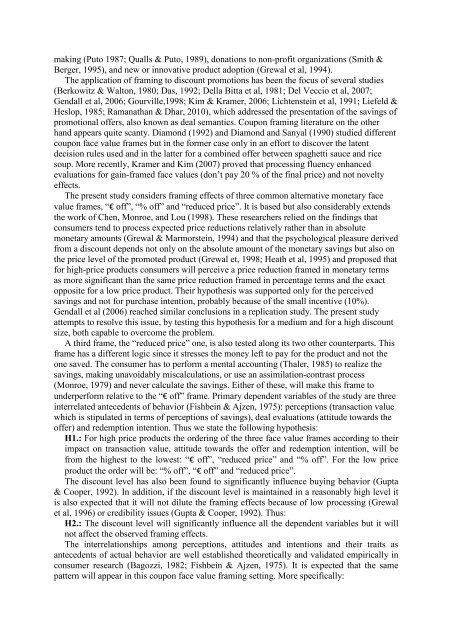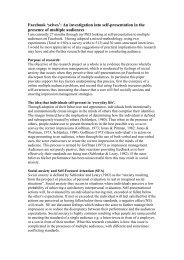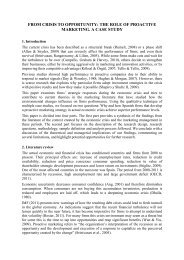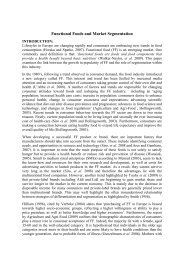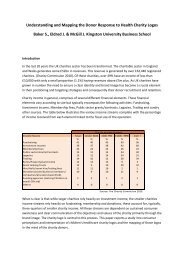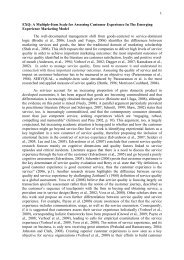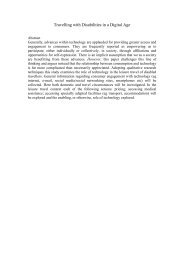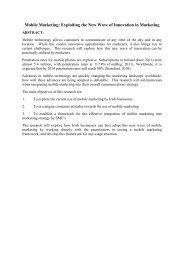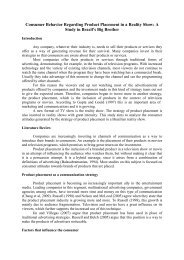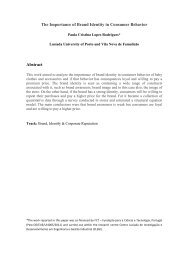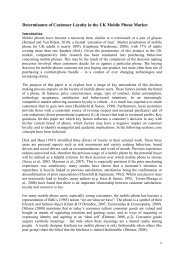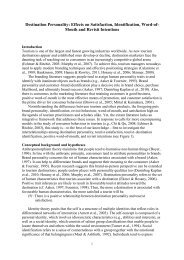Framing effects on evaluation of coupon offers: assessing the ...
Framing effects on evaluation of coupon offers: assessing the ...
Framing effects on evaluation of coupon offers: assessing the ...
You also want an ePaper? Increase the reach of your titles
YUMPU automatically turns print PDFs into web optimized ePapers that Google loves.
making (Puto 1987; Qualls & Puto, 1989), d<strong>on</strong>ati<strong>on</strong>s to n<strong>on</strong>-pr<strong>of</strong>it organizati<strong>on</strong>s (Smith &<br />
Berger, 1995), and new or innovative product adopti<strong>on</strong> (Grewal et al, 1994).<br />
The applicati<strong>on</strong> <strong>of</strong> framing to discount promoti<strong>on</strong>s has been <strong>the</strong> focus <strong>of</strong> several studies<br />
(Berkowitz & Walt<strong>on</strong>, 1980; Das, 1992; Della Bitta et al, 1981; Del Veccio et al, 2007;<br />
Gendall et al, 2006; Gourville,1998; Kim & Kramer, 2006; Lichtenstein et al, 1991; Liefeld &<br />
Heslop, 1985; Ramanathan & Dhar, 2010), which addressed <strong>the</strong> presentati<strong>on</strong> <strong>of</strong> <strong>the</strong> savings <strong>of</strong><br />
promoti<strong>on</strong>al <strong>of</strong>fers, also known as deal semantics. Coup<strong>on</strong> framing literature <strong>on</strong> <strong>the</strong> o<strong>the</strong>r<br />
hand appears quite scanty. Diam<strong>on</strong>d (1992) and Diam<strong>on</strong>d and Sanyal (1990) studied different<br />
coup<strong>on</strong> face value frames but in <strong>the</strong> former case <strong>on</strong>ly in an effort to discover <strong>the</strong> latent<br />
decisi<strong>on</strong> rules used and in <strong>the</strong> latter for a combined <strong>of</strong>fer between spaghetti sauce and rice<br />
soup. More recently, Kramer and Kim (2007) proved that processing fluency enhanced<br />
evaluati<strong>on</strong>s for gain-framed face values (d<strong>on</strong>’t pay 20 % <strong>of</strong> <strong>the</strong> final price) and not novelty<br />
<str<strong>on</strong>g>effects</str<strong>on</strong>g>.<br />
The present study c<strong>on</strong>siders framing <str<strong>on</strong>g>effects</str<strong>on</strong>g> <strong>of</strong> three comm<strong>on</strong> alternative m<strong>on</strong>etary face<br />
value frames, “€ <strong>of</strong>f”, “% <strong>of</strong>f” and “reduced price”. It is based but also c<strong>on</strong>siderably extends<br />
<strong>the</strong> work <strong>of</strong> Chen, M<strong>on</strong>roe, and Lou (1998). These researchers relied <strong>on</strong> <strong>the</strong> findings that<br />
c<strong>on</strong>sumers tend to process expected price reducti<strong>on</strong>s relatively ra<strong>the</strong>r than in absolute<br />
m<strong>on</strong>etary amounts (Grewal & Marmorstein, 1994) and that <strong>the</strong> psychological pleasure derived<br />
from a discount depends not <strong>on</strong>ly <strong>on</strong> <strong>the</strong> absolute amount <strong>of</strong> <strong>the</strong> m<strong>on</strong>etary savings but also <strong>on</strong><br />
<strong>the</strong> price level <strong>of</strong> <strong>the</strong> promoted product (Grewal et, 1998; Heath et al, 1995) and proposed that<br />
for high-price products c<strong>on</strong>sumers will perceive a price reducti<strong>on</strong> framed in m<strong>on</strong>etary terms<br />
as more significant than <strong>the</strong> same price reducti<strong>on</strong> framed in percentage terms and <strong>the</strong> exact<br />
opposite for a low price product. Their hypo<strong>the</strong>sis was supported <strong>on</strong>ly for <strong>the</strong> perceived<br />
savings and not for purchase intenti<strong>on</strong>, probably because <strong>of</strong> <strong>the</strong> small incentive (10%).<br />
Gendall et al (2006) reached similar c<strong>on</strong>clusi<strong>on</strong>s in a replicati<strong>on</strong> study. The present study<br />
attempts to resolve this issue, by testing this hypo<strong>the</strong>sis for a medium and for a high discount<br />
size, both capable to overcome <strong>the</strong> problem.<br />
A third frame, <strong>the</strong> “reduced price” <strong>on</strong>e, is also tested al<strong>on</strong>g its two o<strong>the</strong>r counterparts. This<br />
frame has a different logic since it stresses <strong>the</strong> m<strong>on</strong>ey left to pay for <strong>the</strong> product and not <strong>the</strong><br />
<strong>on</strong>e saved. The c<strong>on</strong>sumer has to perform a mental accounting (Thaler, 1985) to realize <strong>the</strong><br />
savings, making unavoidably miscalculati<strong>on</strong>s, or use an assimilati<strong>on</strong>-c<strong>on</strong>trast process<br />
(M<strong>on</strong>roe, 1979) and never calculate <strong>the</strong> savings. Ei<strong>the</strong>r <strong>of</strong> <strong>the</strong>se, will make this frame to<br />
underperform relative to <strong>the</strong> “€ <strong>of</strong>f” frame. Primary dependent variables <strong>of</strong> <strong>the</strong> study are three<br />
interrelated antecedents <strong>of</strong> behavior (Fishbein & Ajzen, 1975): percepti<strong>on</strong>s (transacti<strong>on</strong> value<br />
which is stipulated in terms <strong>of</strong> percepti<strong>on</strong>s <strong>of</strong> savings), deal evaluati<strong>on</strong>s (attitude towards <strong>the</strong><br />
<strong>of</strong>fer) and redempti<strong>on</strong> intenti<strong>on</strong>. Thus we state <strong>the</strong> following hypo<strong>the</strong>sis:<br />
H1.: For high price products <strong>the</strong> ordering <strong>of</strong> <strong>the</strong> three face value frames according to <strong>the</strong>ir<br />
impact <strong>on</strong> transacti<strong>on</strong> value, attitude towards <strong>the</strong> <strong>of</strong>fer and redempti<strong>on</strong> intenti<strong>on</strong>, will be<br />
from <strong>the</strong> highest to <strong>the</strong> lowest: “€ <strong>of</strong>f”, “reduced price” and “% <strong>of</strong>f”. For <strong>the</strong> low price<br />
product <strong>the</strong> order will be: “% <strong>of</strong>f”, “€ <strong>of</strong>f” and “reduced price”.<br />
The discount level has also been found to significantly influence buying behavior (Gupta<br />
& Cooper, 1992). In additi<strong>on</strong>, if <strong>the</strong> discount level is maintained in a reas<strong>on</strong>ably high level it<br />
is also expected that it will not dilute <strong>the</strong> framing <str<strong>on</strong>g>effects</str<strong>on</strong>g> because <strong>of</strong> low processing (Grewal<br />
et al, 1996) or credibility issues (Gupta & Cooper, 1992). Thus:<br />
H2.: The discount level will significantly influence all <strong>the</strong> dependent variables but it will<br />
not affect <strong>the</strong> observed framing <str<strong>on</strong>g>effects</str<strong>on</strong>g>.<br />
The interrelati<strong>on</strong>ships am<strong>on</strong>g percepti<strong>on</strong>s, attitudes and intenti<strong>on</strong>s and <strong>the</strong>ir traits as<br />
antecedents <strong>of</strong> actual behavior are well established <strong>the</strong>oretically and validated empirically in<br />
c<strong>on</strong>sumer research (Bagozzi, 1982; Fishbein & Ajzen, 1975). It is expected that <strong>the</strong> same<br />
pattern will appear in this coup<strong>on</strong> face value framing setting. More specifically:


